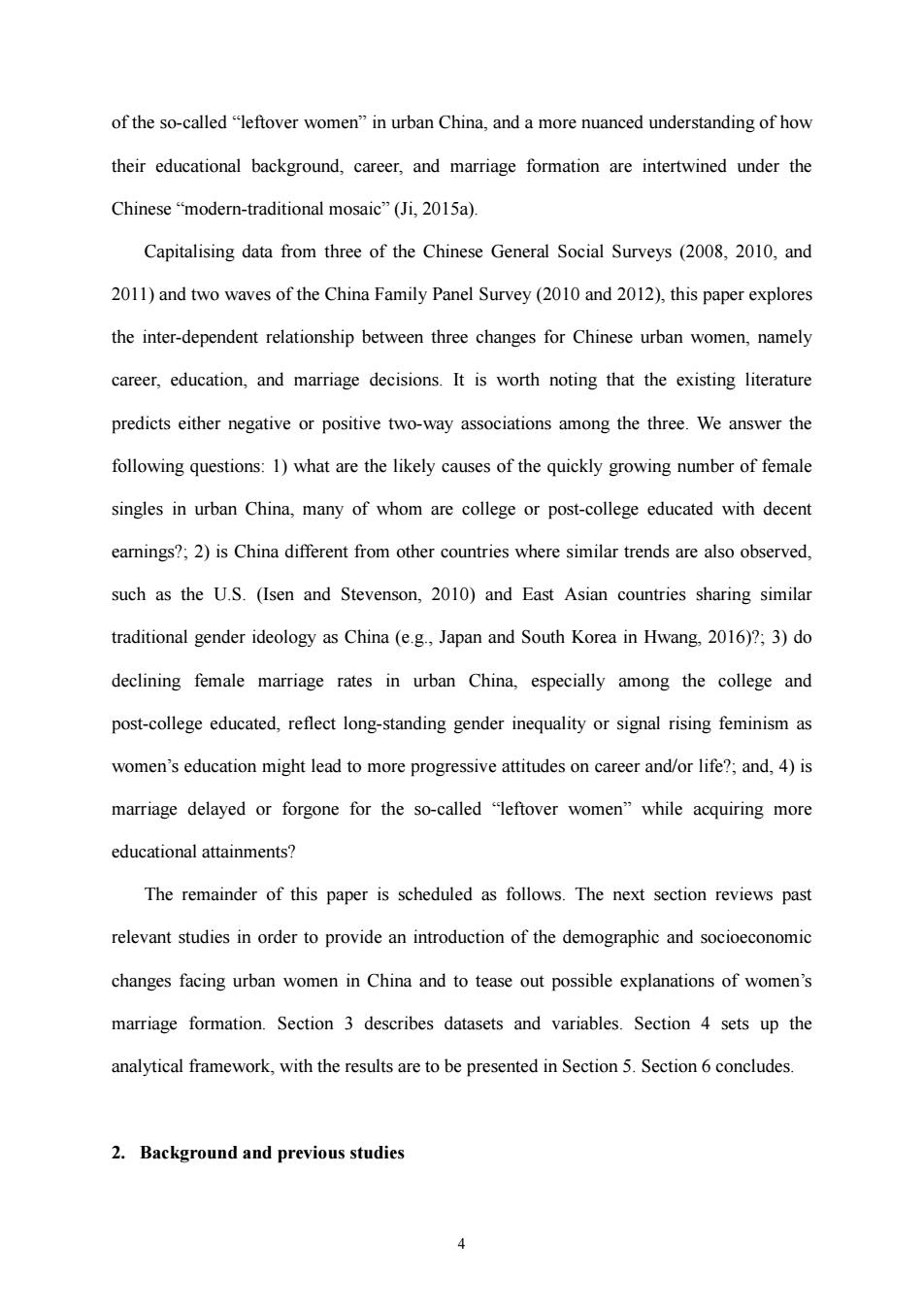正在加载图片...

of the so-called "leftover women"in urban China,and a more nuanced understanding of how their educational background,career,and marriage formation are intertwined under the Chinese "modern-traditional mosaic"(Ji,2015a) Capitalising data from three of the Chinese General Social Surveys (2008,2010,and 2011)and two waves of the China Family Panel Survey(2010 and 2012),this paper explores the inter-dependent relationship between three changes for Chinese urban women,namely career,education,and marriage decisions.It is worth noting that the existing literature predicts either negative or positive two-way associations among the three.We answer the following questions:1)what are the likely causes of the quickly growing number of female singles in urban China,many of whom are college or post-college educated with decent earnings?;2)is China different from other countries where similar trends are also observed, such as the U.S.(Isen and Stevenson,2010)and East Asian countries sharing similar traditional gender ideology as China (e.g.,Japan and South Korea in Hwang,2016)?;3)do declining female marriage rates in urban China,especially among the college and post-college educated,reflect long-standing gender inequality or signal rising feminism as women's education might lead to more progressive attitudes on career and/or life?;and,4)is marriage delayed or forgone for the so-called "leftover women"while acquiring more educational attainments? The remainder of this paper is scheduled as follows.The next section reviews past relevant studies in order to provide an introduction of the demographic and socioeconomic changes facing urban women in China and to tease out possible explanations of women's marriage formation.Section 3 describes datasets and variables.Section 4 sets up the analytical framework,with the results are to be presented in Section 5.Section 6 concludes. 2.Background and previous studies 44 of the so-called “leftover women” in urban China, and a more nuanced understanding of how their educational background, career, and marriage formation are intertwined under the Chinese “modern-traditional mosaic” (Ji, 2015a). Capitalising data from three of the Chinese General Social Surveys (2008, 2010, and 2011) and two waves of the China Family Panel Survey (2010 and 2012), this paper explores the inter-dependent relationship between three changes for Chinese urban women, namely career, education, and marriage decisions. It is worth noting that the existing literature predicts either negative or positive two-way associations among the three. We answer the following questions: 1) what are the likely causes of the quickly growing number of female singles in urban China, many of whom are college or post-college educated with decent earnings?; 2) is China different from other countries where similar trends are also observed, such as the U.S. (Isen and Stevenson, 2010) and East Asian countries sharing similar traditional gender ideology as China (e.g., Japan and South Korea in Hwang, 2016)?; 3) do declining female marriage rates in urban China, especially among the college and post-college educated, reflect long-standing gender inequality or signal rising feminism as women’s education might lead to more progressive attitudes on career and/or life?; and, 4) is marriage delayed or forgone for the so-called “leftover women” while acquiring more educational attainments? The remainder of this paper is scheduled as follows. The next section reviews past relevant studies in order to provide an introduction of the demographic and socioeconomic changes facing urban women in China and to tease out possible explanations of women’s marriage formation. Section 3 describes datasets and variables. Section 4 sets up the analytical framework, with the results are to be presented in Section 5. Section 6 concludes. 2. Background and previous studies